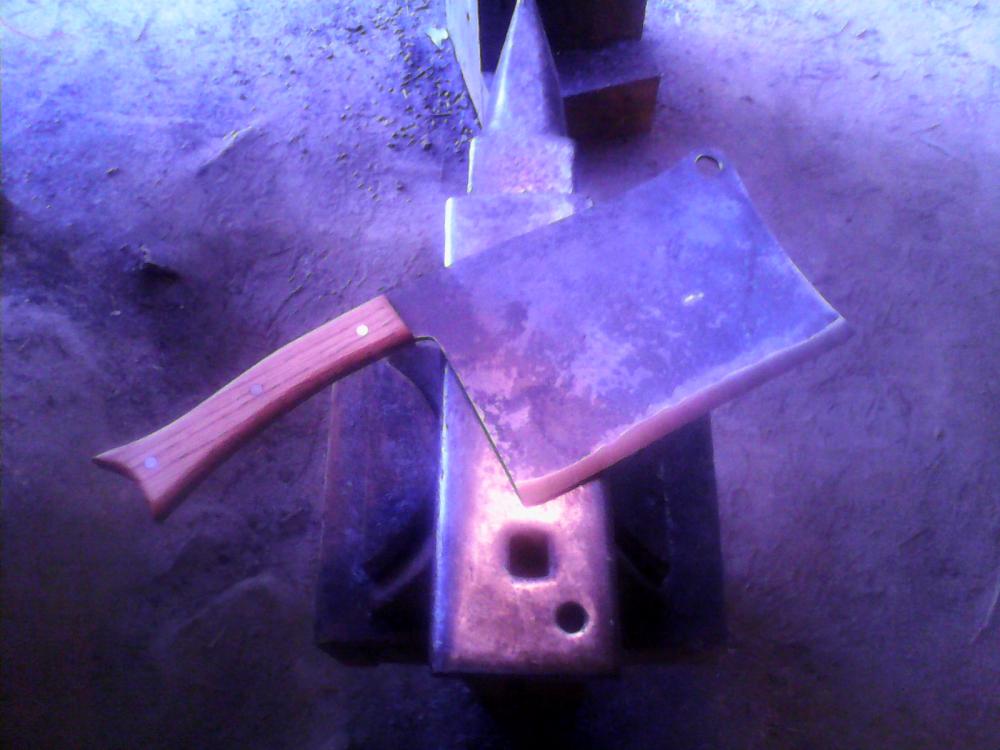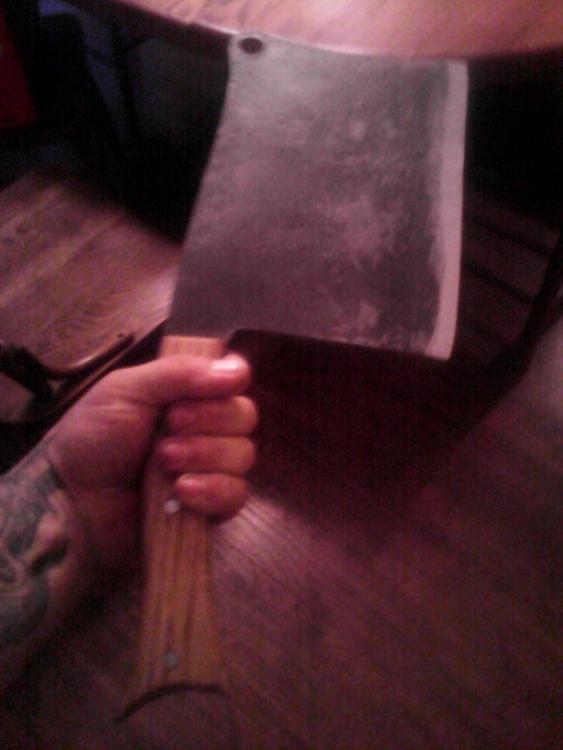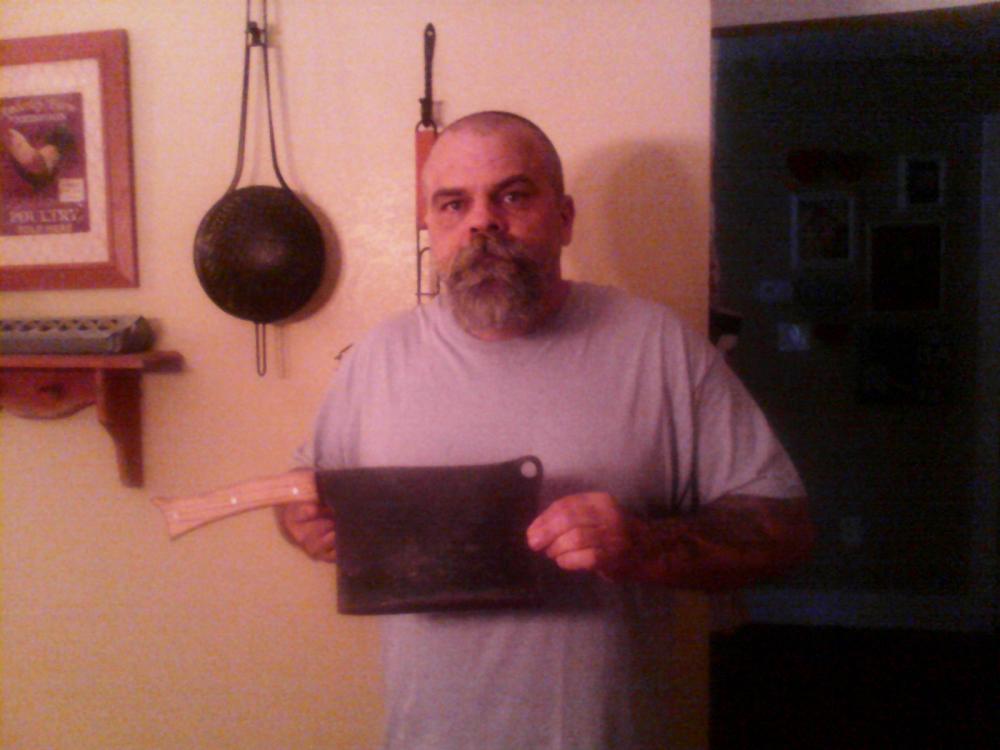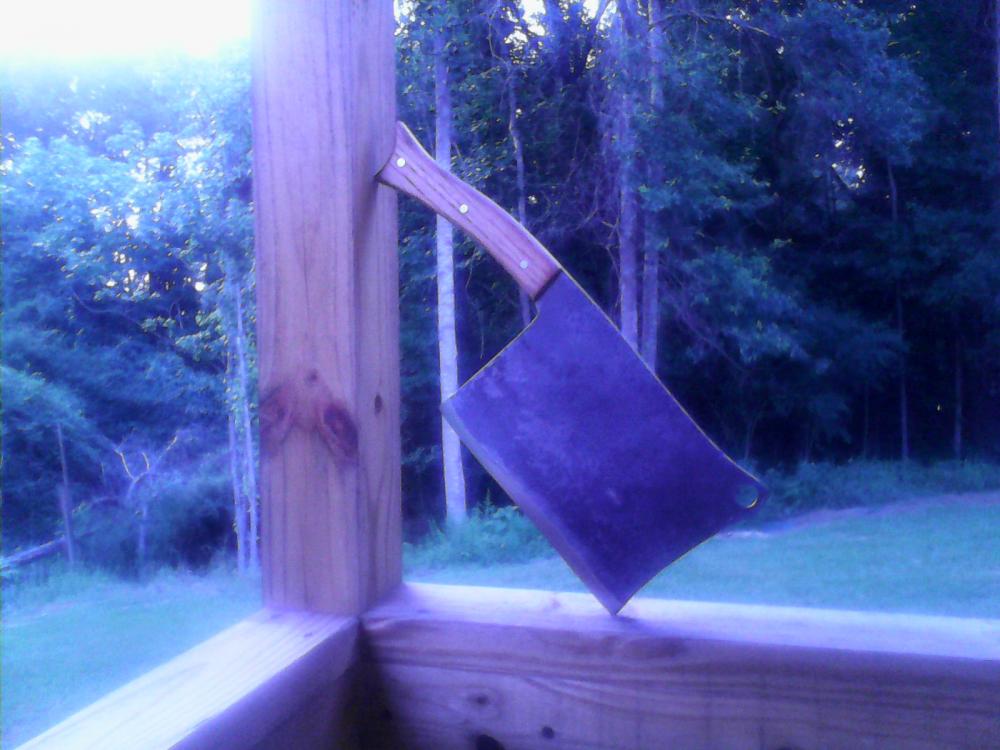-
Posts
450 -
Joined
-
Last visited
Content Type
Profiles
Forums
Articles
Gallery
Downloads
Events
Everything posted by TwistedCustoms
-
Great haul matto! Congrats.
-
Thanks to SLAG and Thomas for the effort typing out the info and siting sources. Very interesting stuff. Also a reminder that my local library is sub-par. Thank God for inter library loan!
-
smithing, or just really big hammers?
TwistedCustoms replied to bustedknuckles's topic in Hand Hammers
I have a 12lb like the top one. Its cast steel, stamped "alloy" IIRC. I was told railroad hammer but no intended use. -
I also have a MH sans pritchel. I read that no pritchel on a MH dates it pre 1835. I have one with pritchel as well, both great anvils. To the OP, buy them all! That Mouse Hole does look odd. May just be the angle of the photo but the base looks too small for the length of the horn and heel. Are Soderfors cast steel or laminated construction? I've never seen one.
-
New Knife and looking for advice
TwistedCustoms replied to Jeremy the other one's topic in Knife Making
If you want a more precise cross section make a bottom and top tool with the profile you want. You can make your tooling slightly oversize to accommodate the amount of grinding you want to do to reveal a specific layer of the pattern weld. Forging between dies will be faster and more accurate and if you use them on a mono-steel piece you won't even have to grind. -
Nice looking stuff little blacksmith. The small skinner is my favorite but the Bowie looks like a good companion for the cap and ball pistol.
-
something i've been working
TwistedCustoms replied to The Rusty Forge's topic in Blacksmithing, General Discussion
Nice looking setup, I started forging with a lot less. There is lots of info here on setting up a smithy. The way I determine anvil height is standing naturally with arms at side making a fist. My anvil height is where my knuckles rest on the anvil top. If you have a welder you could extend the legs of the angle iron base to raise it a bit. Stooping over to hammer gets old fast! Forge on! -
Welcome to the addiction! Lots of good info and good folks on this site. If you ever get over to Ole Miss check out the Ms Ag and Forestry Museum in Jackson. The Ms forge council meets there the third Sat of every month at 9am. Its a cool old smithy reconstructed from another site in Ms and is now part of the living history museum. There are eight forges, anvils, post vises etc., basically eight full work stations in the smithy so plenty of room to get in the fire if you decide to come down.
-
I also think neckers are somewhat tedious compared to other carry options but I read one plausible explaination. It was something to do with the possibility of falling through thin ice in the northern European countries. I don't know why it would be easier to get to on your neck than on your belt but I think its a traditional carry method in Sweden and Norway. EJRailRoadTrack, I do like small knives and that's a very cool first knife.
-
Masterfully executed. Functional art is the highest form of art. Well done!
-
Tempering in an Oven or a Grill
TwistedCustoms replied to Redneck carp's-tongue's topic in Heat Treating Knives, Blades etc
1095 shouldn't crack at any point after the quench. If you normalize during the forging and again before you harden you shouldn't have problems. I let ten-hundred series steels cool to room temp after quenching and wire brush the scale and oil completely off the blades before tempering whether I'm using an oven or drawing heat from a sacrificial piece of steel to watch the colors run and temper by eye. Toaster ovens tend to have big heat swings but you can compensate for that somewhat by going on the high end of the heat range. Most toaster ovens don't go over 450f . Start with your temper cycles at max heat for your toaster oven and then see if a file skates on the blade. If the file cuts your blade easily you can re-harden and try again at lower heat. Bottom line, without precision equipment you won't get precision, predictable results without some trial and error. You can get good, repeatable results by keeping notes, only changing one thing at a time on each run through and doing it exactly the same way once you get the desired results. I've never even thought of using a gas grill but if you have one with a thermostat try it and see what works. You could also stack fire bricks inside your gas grill to make an insulated chamber, an oven in an oven. Place a second temperature probe inside your brick pile so you know exactly what's going on in the inner chamber and see if you can find a grill setting that holds that inner chamber steady at a desired temp. -
Thanks Thomas. It will probably see a lot more action at the woodpile than on beef ribs :-) I cook a whole hog when I can find fifty or so people who want to eat pulled pork but that's only once in a blue moon. When I lived in North Texas my boss used to take me up to one of his ranches in Oklahoma to butcher a cow every year. The kit was 1) 30-06 1) chain saw 1) axe 1) shoe box full of old hickory butcher knives. We would grind the whole thing into hamburger and he would fill up all his workers freezers with free meat. He was a good boss. I don't think I've ever used a cleaver, just always like liked the look of them.
-
Made from an old tractor disc. 3/16" thick, I've made a bunch of small knives and other tools out of half the disc. The other half has been under my storage rack since winter and a couple of days ago it started calling to me. The blade is approx 6" tall by 9" long. Hardened in canola oil and triple tempered to straw. The handle scales are hickory with three 1/4" steel pins. Edge is convexed. Its always touch and go tempering by eye but I think I got a keeper. I split a pile of hardwood with it this afternoon and stuck it and twisted it out of the chopping block several times. No chips and it still cut paper. Not very scientific but that's my method.
-
Thank you for saying so. This is how I received my first hammer and it was a life changing experience for me. Now that I'm recruiting strikers I actually think it's to my advantage. I've never really had any ambitions for a power hammer and barring that having a striker is the only way to produce some of the tools I cherish.
-
I haven't felt any negative impact from all the hype, yet. Of course I'm not shopping for an anvil but even so I'm still running into them for reasonable prices in my area. I haven't watched any of the blacksmithing cable shows yet but I hear about it from lots of customers. A friend of mine is going out the end of this month to be filmed for an upcoming Forged in Fire. He's a member here so I'll wait and see if he wants to post about it before I blab but I'm looking forward to watching the show for the first time and seeing a buddy. The last time I ordered coal and coke (by the ton) it was lower than the order before but I chalk that up to better fuel prices to get it from Pensilvania to Mississippi. As for customer acquisition costs, my repeat customers are my best salesmen and produce a steady stream of new customers. Fads come and go but if even one person in a thousand who's first exposure to blacksmithing is a cable show finds their passion and becomes a true blacksmith it will be good for the craft. We all got the bug from somewhere! I've had a few guys who have never swung a hammer who wanted to purchase a hammer. I tell them I won't sell them one but they can strike two hammers for me, I'll keep one and they can keep one. I'll sell mine to an established smith who is short of time and the prospective smith gets a small taste of the realities of smithing with no out of pocket cost. I'm not trying to keep hammers out of the hands of beginners, I'm trying to put them into hands that will use them. Since I don't own a power hammer this works out for both parties. I've been surprised at times at some of the guys who have followed through and gone home with a new rounding hammer they had a hand in making. Even if they never go any further down the rabbit hole they at the very least have a new level of understanding of what's involved in forging.
-
Fine job, I like it a lot! I'll bet mother is happy.
-
Very cool Steve, thanks for sharing the link. I've read lots of theories about the ritual "killing" of swords and spear heads but sadly the Vikings and earlier iron age folks who did it didn't leave much information as to why. My favorite theory has always been that they viewed a dead person as "broken" in this world but believed they would be made whole and at their best in the afterlife so in order for the weapon to arrive whole and usable it had to be ritually "killed" to follow it's master. I like this reasoning but it begs the question, why the sword and not the tools. I'll probably never know but it's fun to ponder.
-
Air hardening steels require very precise temperature control for forging and heat treating. No tricks involved, just very precise steps. If you have a controlled atmosphere furnace or a good oven and stainless foil it can be done but it will require a much higher up-front investment in equipment. IMHO a steel like D2 would be a waste of time and resources for a hawk. You can forge an axe head from a water hardening steel like 4140 and temper it by eye just by inserting hot drifts into the eye of the axe after hardening and watching the colors run down to the edge. Tempering D2 to RC in the mid 40s, which is where an axe needs to be, will require an oven that can hold it steady at between 1100 and 1200 hundred for an extended period. It's not complicated, it just requires equipment not typically found in a blacksmith shop. If you do decide to forge it please update us with photos and tell us how it went!
-
pink handle design help ?!?!
TwistedCustoms replied to dps9999's topic in Finish and Polish for Knives
I don't know about your area but around here there are lots of custom gun builders who produce high end AR type rifles and they all do Cerakote in every color under the sun. Well, maybe not every color but I've seen pink on several builds at gun shows. One of my customers bought a knife from me last year and had it Cerakoted tan by his gunsmith. He brought it by the shop to show me and I kinda liked it. When he bought the knife it was satin finished 1095, when he showed it to me a couple of months ago it was non reflective desert tan. I don't know how durable it would be on a knife blade but it looked good. It's a two part, oven curing ceramic coating so it may hold up well. If you can find a shop that's already set up to do it I'm sure you could get a small batch "pinked" pretty inexpensively. -
hand forged "perfect handle" screwdriver
TwistedCustoms replied to bobasaurus's topic in Member Projects
Very nice, any cabinet maker doing period work would love to own a set of those in graduated sizes. Well done! -
Hard to tell about duplicates on the hammers/swages etc but based on prices in my area for the items shown I would offer $1000usd in cash of course, and that's depending on anvil rebound/condition. I've heard about prices being crazy high in other areas but I can get the hammer heads for $3-$5 each, the pipe vise for $20, the forge and blower together for $250. If you piece it all out there is a lot more than a grand there but if the seller wants to convert it to quick cash....on the other hand the seller may think he can retire off the sale in which case let some sucker over pay, everything there can be found elsewhere. Try a thousand dollar offer and see what happens.
-
1-you catch on fire and it's no big deal 2-you notice the coal black under your fingernails every time you go to a restaurant 3-you leave power tools out for the taking but lock up hammers and punches at the end of the day 4- you often have pieces of rusty "treasure" in the trunk of your car 5-you know that 0•3•9 = 93lbs 6-you think 1000°f is cold 7-your biggest vice is too many vises 8-you've ever thought of opening a rescue shelter for abused and neglected anvils 9- you know all sorts of highly technical and precise trade terms like, "mellow fire" or " hateful fire", or the difference between "squishing" and "smooshing" 10-you have never watched a single episode of "Forged in Fire" but all your customers tell you about it non-stop :-)
-
Well said.
-
New Forge Build and First Fire
TwistedCustoms replied to TwistedCustoms's topic in Solid Fuel Forges
Flux core wire, no shielding gas. No grate, I left about a 3/8" gap on both sides of the clinker breaker which works great with the coke I burn.




